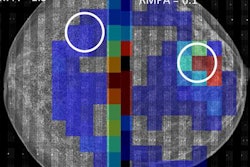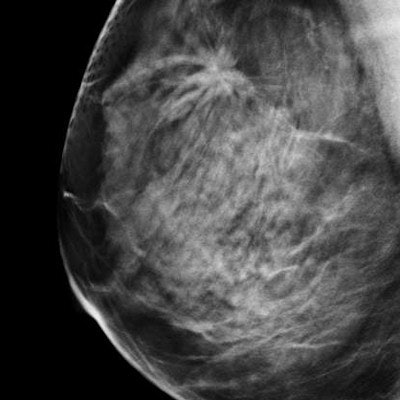
Italian researchers have proved a combination of phantoms, an automatic software tool, and a statistical process are effective and applicable on a large scale to vet the image quality and reproducibility for any type of digital mammography system.
The group used the method on 25 digital mammography systems within the Veneto region of Italy. They compared image quality indexes using their method with corresponding indexes previously determined by a baseline procedure and found their method is reproducible and applicable on a large scale.
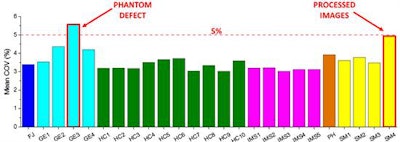 Mean of the coefficients of variations (COVs) of all 15 image quality indexes for each system. Data are grouped and colored by system brand. The horizontal line represents 5% variability. All images courtesy of Dr. Gisella Gennaro and European Radiology.
Mean of the coefficients of variations (COVs) of all 15 image quality indexes for each system. Data are grouped and colored by system brand. The horizontal line represents 5% variability. All images courtesy of Dr. Gisella Gennaro and European Radiology."This retrospective analysis from the large image dataset produced by 25 digital mammography units and collected within a two-year regional project has demonstrated that, overall, reproducibility of image quality produced by full-field digital mammography systems is excellent," noted lead author Dr. Gisella Gennaro, a medical physicist from the Veneto Institute of Oncology in Padua, and colleagues (European Radiology, 27 January 2017).
Why test image quality?
Radiologists often assume that image quality of mammograms is high, but the image quality should first be guaranteed by suitable optimization actions, and subsequently monitored by quality controls, rather than assumed in advance, the researchers explained.
Routine tests are recommended to ensure the image quality assessed at the mammography system's installation remains unchanged. Current guidelines suggest a simple phantom -- plastic material of appropriate thickness equal to absorption of a typical breast -- and a single detail to produce a large-area-signal against the surrounding background on the resulting image is enough to test reproducibility performance.
However, the use of a single parameter extracted from a single phantom image is statistically limited and accounts weakly for the normal fluctuations in the image formation process, they wrote. Commercial phantoms are an alternative; they contain several details, a series of low- and high-contrast details, differences in size and shape, spatial resolution patterns, and step wedges for contrast resolution evaluation. Also, appropriate algorithms capable of analyzing phantom images and measuring one or more objective image quality indexes from each detail available in the phantom are appropriate.
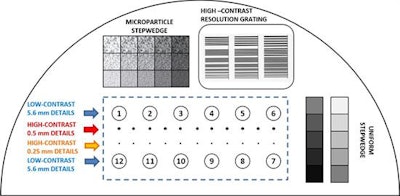 Layout of the Leeds TOR MAS test object. The test plate includes 12 circular details 5.6 mm in diameter, with nominal contrast diminishing from 8.3% to 0.15%, for low-contrast sensitivity measurements; 11 circular details 0.5 mm in diameter and 11 0.25 mm; a step wedge with 8-mm square strips producing a 10-point scale for contrast and dynamic range evaluations; three five-point step wedges incorporating small irregular-shaped particles for noise measurements at different contrasts; a high-contrast resolution grating, with 26 groups of bar patterns in a range of spatial frequencies from 1.0 lp/mm to 20.0 lp/mm.
Layout of the Leeds TOR MAS test object. The test plate includes 12 circular details 5.6 mm in diameter, with nominal contrast diminishing from 8.3% to 0.15%, for low-contrast sensitivity measurements; 11 circular details 0.5 mm in diameter and 11 0.25 mm; a step wedge with 8-mm square strips producing a 10-point scale for contrast and dynamic range evaluations; three five-point step wedges incorporating small irregular-shaped particles for noise measurements at different contrasts; a high-contrast resolution grating, with 26 groups of bar patterns in a range of spatial frequencies from 1.0 lp/mm to 20.0 lp/mm.Software tools to measure image quality from phantom images improve sensitivity and precision of measurements, compared with human-based measurements, and variations of the image quality indexes over time can be used to monitor long-term reproducibility of a mammography unit and detect possible meaningful variations.
Gennaro and colleagues used the commercial phantom TOR MAS (Leeds Test Objects) to test the reproducibility of 25 digital mammography systems in their regional screening program. They used the web version of automatic software tool AutoPIA (automatic phantom image analysis; CyberQual) to analyze phantom images and produce 60 quantitative image quality indexes. They selected 15 for comparison with image quality index reference values and for assessment of image quality reproducibility over time.
How well did the method perform?
The researchers collected a total of 2,553 TOR MAS images from the 25 digital mammography systems between March 2013 and December 2014. The mean number of images per site was 102, and the mean time interval over which the test was performed was 16 months.
Most of the systems showed excellent image quality reproducibility over the surveillance interval, with mean variability well below 5%.
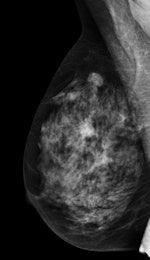
"The added value of the method for reproducibility tests illustrated in this paper is that the software tool employed enables the use of a complex phantom, containing several details, of different types," they pointed out. "The analysis of phantom images permits the acquisition of a full picture of image quality, covering different aspects, such as contrast, noise, and spatial resolution, by means of multiple objective image quality [indexes], automatically determined, without any action by the users besides phantom exposure."
In addition, the automation makes routine quality control effective and easily obtainable at a low cost.
The researchers also advocated the use of a cloud application to guarantee full scalability of the monitored mammography network.
"An arbitrarily large number of mammography units can be linked together and perform effective quality controls at limited costs, while gathering a huge amount of data, useful for intersystem comparison and research purposes," Gennaro and colleagues wrote.






